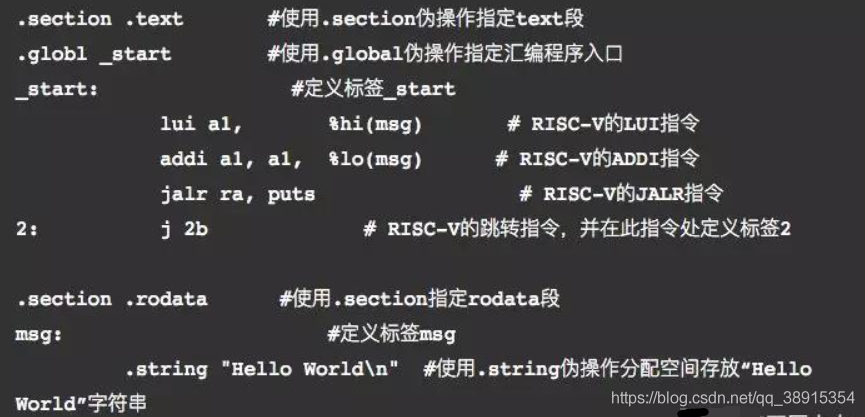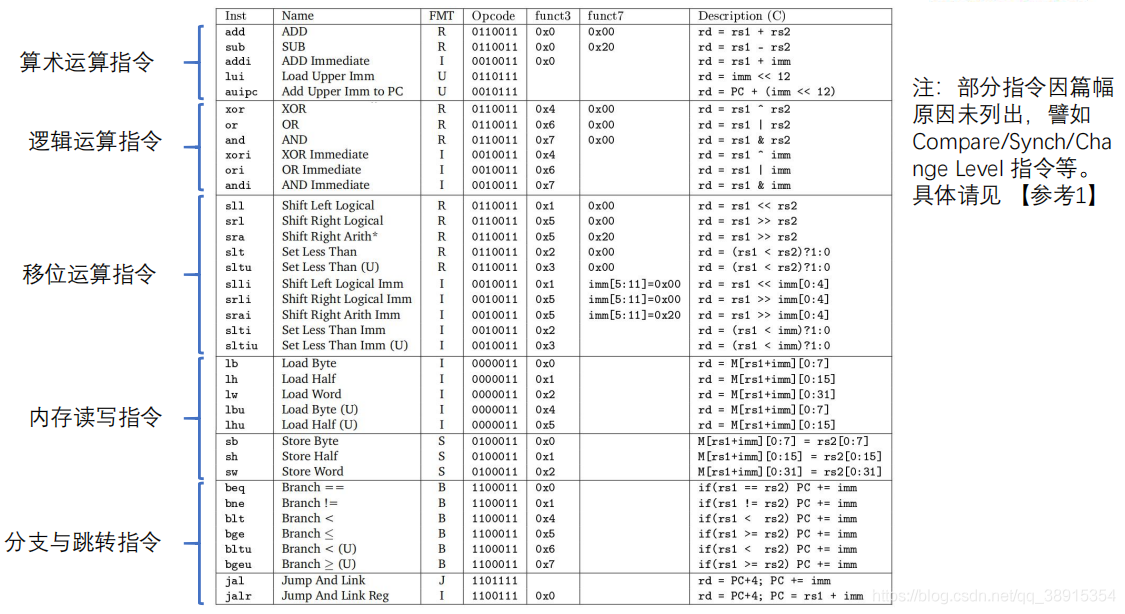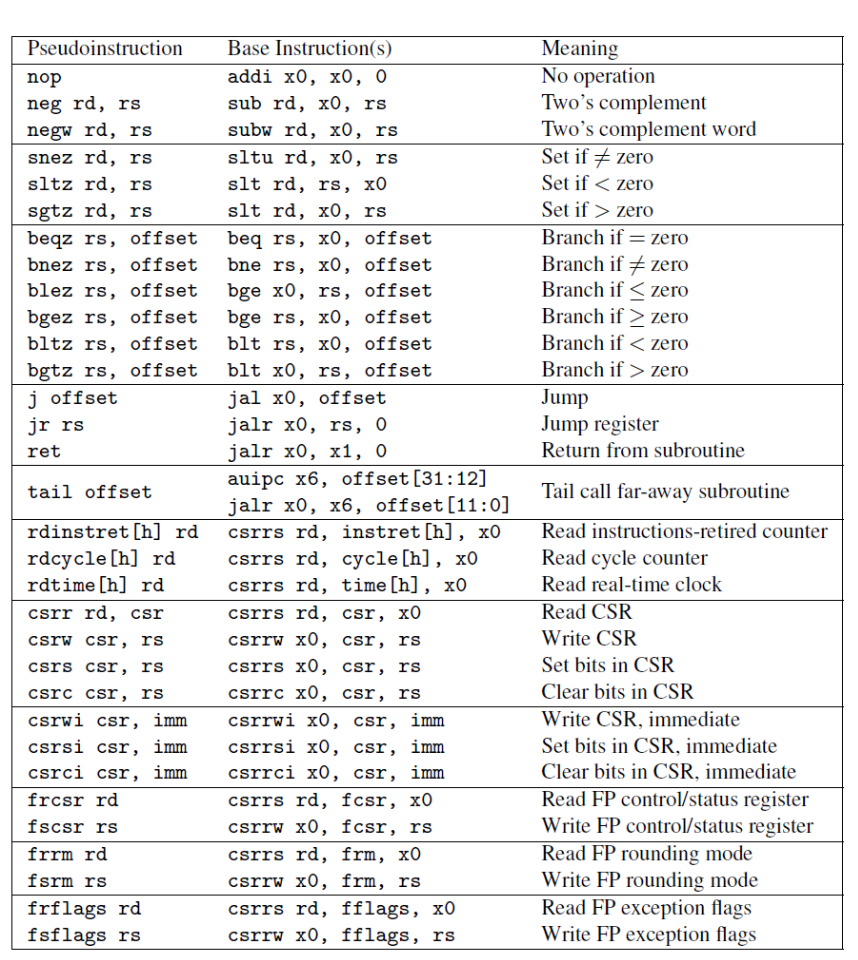RISC-V汇编
语法介绍
- 一个完整的 RISC-V 汇编程序有多条 语句 (statement) 组成。
- 一条典型的 RISC-V 汇编 语句 由 3 部分组成:
[ label:][ operation] [ comment]- label(标号): GNU汇编中,任何以冒号结尾的标识符都被认为是一个标号。表示当前指令的位置标记。
- operation 可以有以下多种类型:
- instruction(指令): 直接对应二进制机器指令的字符串。例如addi指令、lw指令等。
- pseudo-instruction(伪指令): 为了提高编写代码的效率,可以用一 条伪指令指示汇编器产生多条实际的指令(instructions)。
- directive(指示/伪操作): , 通过类似指令的形式(以“.”开头),通知汇 编器如何控制代码的产生等,不对应具体的指令。
- macro:采用 .macro/.endm 自定义的宏
- comment(注释): 常用方式,“#” 开始到当前行结束。

指令集合
risc-v汇编指令分类主要有以下几种:算数运算指令、逻辑运算指令、位移运算指令、内存读写指令、分支与跳转指令

伪指令:
伪指令不是真的机器指令,会被汇编器翻译为真实的物理指令,例如: ret 被汇编为:jalr x0, x1, 0


Pseudo Ops
Both the RISC-V-specific and GNU .-prefixed options.
The following table lists assembler directives:
| Directive | Arguments | Description |
|---|---|---|
| .align | integer | align to power of 2 (alias for .p2align) |
| .file | “filename” | emit filename FILE LOCAL symbol table |
| .globl | symbol_name | emit symbol_name to symbol table (scope GLOBAL) |
| .local | symbol_name | emit symbol_name to symbol table (scope LOCAL) |
| .comm | symbol_name,size,align | emit common object to .bss section |
| .common | symbol_name,size,align | emit common object to .bss section |
| .ident | “string” | accepted for source compatibility |
| .section | [{.text,.data,.rodata,.bss}] | emit section (if not present, default .text) and make current |
| .size | symbol, symbol | accepted for source compatibility |
| .text | emit .text section (if not present) and make current | |
| .data | emit .data section (if not present) and make current | |
| .rodata | emit .rodata section (if not present) and make current | |
| .bss | emit .bss section (if not present) and make current | |
| .string | “string” | emit string |
| .asciz | “string” | emit string (alias for .string) |
| .equ | name, value | constant definition |
| .macro | name arg1 [, argn] | begin macro definition \argname to substitute |
| .endm | end macro definition | |
| .type | symbol, @function | accepted for source compatibility |
| .option | {rvc,norvc,pic,nopic,relax,norelax,push,pop} | RISC-V options. Refer to .option for a more detailed description. |
| .byte | expression [, expression]* | 8-bit comma separated words |
| .2byte | expression [, expression]* | 16-bit comma separated words |
| .half | expression [, expression]* | 16-bit comma separated words |
| .short | expression [, expression]* | 16-bit comma separated words |
| .4byte | expression [, expression]* | 32-bit comma separated words |
| .word | expression [, expression]* | 32-bit comma separated words |
| .long | expression [, expression]* | 32-bit comma separated words |
| .8byte | expression [, expression]* | 64-bit comma separated words |
| .dword | expression [, expression]* | 64-bit comma separated words |
| .quad | expression [, expression]* | 64-bit comma separated words |
| .dtprelword | expression [, expression]* | 32-bit thread local word |
| .dtpreldword | expression [, expression]* | 64-bit thread local word |
| .sleb128 | expression | signed little endian base 128, DWARF |
| .uleb128 | expression | unsigned little endian base 128, DWARF |
| .p2align | p2,[pad_val=0],max | align to power of 2 |
| .balign | b,[pad_val=0] | byte align |
| .zero | integer | zero bytes |
| .variant_cc | symbol_name | annotate the symbol with variant calling convention |
.option
rvc/norvc
Enable/disable the C-extension for the following code region.
pic/nopic
Set the code model to PIC (position independent code) or non-PIC. This will
affect the expansion of the la pseudoinstruction, refer to
listing of standard RISC-V pseudoinstructions.
relax/norelax
Enable/disable linker relaxation for the following code region.
NOTE: Code region follows by .option relax will emit
R_RISCV_RELAX/R_RISCV_ALIGN even linker unsupport relaxation, suggested
usage is using .option norelax with .option push/.option pop if
you want to disable linker relaxation on specific code region.
NOTE: Recommended way to disable linker relaxation of specific code region is
use .option push, .option norelax and .option pop, that prevent enabled
linker relaxation accidentally if user already disable linker relaxation.
push/pop
Push/pop current options to/from the options stack.


...